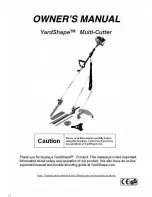
PH2010
pH SOILTESTER
_____________________________________________________________________________________________
2
How to use the pH-meter
1.
Take the instrument out of its case and check that the needle indicates
pH 7 (fig.1). If this is not the case it can be very simple adjusted. Remove
the cover and glass window from the instrument and carefully turn the
adjusting screw clockwise or counter-clockwise, as the case may be.
2.
The electrode is very vulnerable and should carefully cleaned with
water and dried with a clean cloth before and after use (fig.2). This is
very important since otherwise the reading is not correct. After
cleaning, the electrodes should not get in contact with anything, not
even with your hands since these always give off some transpiration,
however slight, and this would adversely affect the readings.
3.
Fill the soil holder with the soil under test and pack the soil so as to be
sure that the complete electrode surface will be in contact with it.
Insert the instrument into the soil until the silver-colored electrodes are
completely covered with soil. Then turn the instrument two or three
times about its longitudinal axis to ensure good contact between soil
and electrodes (fig.3). Black earth, clay. loam etc. should have a
moisture content (shown on the meter) between 50 and 70%. If the soil
is too wet, the water should be pressed out until the moisture content is
at a minimum 50%. Humus rich soil may have higher moisture content,
even exceeding 100% as is often the case. If the soil is too dry, the pH
cannot be measured; in that case it should first be moistened with
distilled water; readings can then be taken after about 2 hours.
4.
To measure the moisture content in the soil, press the white button; the
moisture content can be read off immediately. After use, clean the
electrodes thoroughly with water and wipe off with a dry cloth (fig.2).
Normal soil used for cultivation will seldom have a moisture content
below 30% as is the case e.g. with dry sand.
5.
It takes the needle about three minutes to get stabilized. Next the pH
can be read off (fig.4). DO NOT allow the meter to stay in the soil for
more than 5 minutes. This will prevent undue corrosion of the
electrodes.
Summary of Contents for PH2010
Page 1: ...USER MANUAL PH2010 pH SOILTESTER ...
Page 4: ......






















